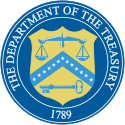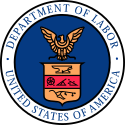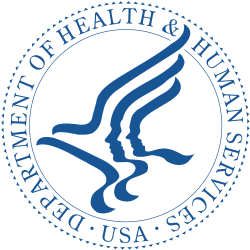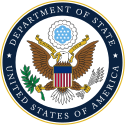USA's ministerier
| Denne artikel er en del af en serie om |
| Politik i USA |
|---|
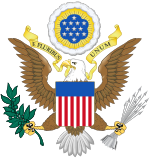 |
| Andre lande |
De amerikanske ministerier ledes hver af en minister, som udnævnes af USA's præsident, og som skal godkendes af Senatet. For eksempel ledes udenrigsministeriet af udenrigsministeren (Secretary of State), som for nuværende (siden 2021) er Antony Blinken.
Alle ministre er medlemmer af det amerikanske kabinet, som er den øverste politiske ledelse af det amerikanske samfund. Ministerie
Nuværende ministerier
| Ministerium | Sejl | Flag | Oprettet | Ansatte | Samlet budget | Titel | Noter |
|---|---|---|---|---|---|---|---|
| Udenrigsministeriet (Department of State) |  |  | 27. juli 1789 | 30.000 (2023) | $58.1 mia.[1] (2023) | Secretary of State | |
| Finansministeriet (Department of the Treasury) |  | 2. september 1789 | 100.000 (2023) | $16.4 mia.[2] (2023) | Secretary of the Treasury | ||
| Forsvarsministeriet (Department of Defence) | 8. september 1947 | 3.200.000 (2023) | $852 mia.[3] (2023) | Secretary of Defense | Herunder sorterer Hær-, Luftvåben- og Marineministeriet | ||
| Justitsministeriet (Department of Justice) |  | 1. juli 1870 | 113.543 (2012) | $37.5 mia.[4] (2023) | Attorney General | Posten som justitsminister allerede oprettet 1789 | |
| Indenrigsministeriet (Department of Interior) |  |  | 3. marts 1849 | 70.000 (2023) | $35 mia.[5] (2023) | Secretary of the Interior | |
| Landbrugsministeriet (Department of Agriculture) |  | 15. maj 1862 | 100.000 (2023) | $242 mia.[6] (2023) | Secretary of Agriculture | ||
| Handelsministeriet (Department of Commerce) |  | 14. februar 1903 | 41.000 (2023) | $16.3 mia.[7] (2023) | Secretary of Commerce | Tidligere Handels- og arbejdsministeriet, Arbejdsministeriet senere udskilt | |
| Arbejdsministeriet (Department of Labor) |  | 4. marts 1913 | 15.000 (2023) | $97.5 mia.[8] (2023) | Secretary of Labor | ||
| Sundhedsministeriet (Department of Health and Human Services) |  | 11. april 1953 | 65.000 (2023) | $1.772 mia.[9] (2023) | Secretary of Health and Human Services | Tidligere Sundheds-, undervisnings- og velfærdsministeriet, Undervisningsministeriet senere udskilt | |
| Bolig- og byplanministeriet (Department of Housing and Urban Development) |  | 9. september 1965 | 9.000 (2023) | $61.7 mia.[10] (2023) | Secretary of Housing and Urban Development | ||
| Transportministeriet (Department of Transportation) |  |  | 1. april 1967 | 55.000 (2023) | $145 mia.[11] (2023) | Secretary of Transportation | |
| Energiministeriet (Department of Energy) |  | 4. august 1977 | 10.000 (2023) | $45.8 mia.[12] (2023) | Secretary of Energy | ||
| Undervisningsministeriet (Department of Education) |  | 17. oktober 1979 | 4.200 (2023) | $79.6 mia.[13] (2023) | Secretary of Education | ||
| Veteranministeriet (Department of Veterans Affairs) |  | 15. marts 1989 | 235.000 (2023) | $308.5 mia.[14] (2023) | Secretary of Veterans Affairs | ||
| Sikkerhedsministeriet (Department of Homeland Security) |  | 25. november 2002 | 250.000 (2023) | $101.6 mia.[15] (2023) | Secretary of Homeland Security |
Tidligere ministerier
| Ministerie | Eksisterede | Noter |
|---|---|---|
| Krigsministeriet (Department of War) | 1789-1947 | Erstattet af Forsvarsministeriet |
| Flådeministeriet (Department of the Navy) | 1798-1947 | Erstattet af Forsvarsministeriet |
| Postministeriet (Post Office Department) | 1872-1971 | Reorganiseret som delvis uafhængig tjeneste, United States Postal Service |
| Handels- og arbejdsministeriet (Department of Commerce and Labor) | 1903-1913 | Delt op i Handelsministeriet og Arbejdsministeriet |
| Sundheds-, undervisnings- og velfærdsministeriet (Department of Health, Education, and Welfare) | 1953-1979 | Delt op i Sundhedsministeriet og Undervisningsministeriet |
Referencer
- ^ "Congressional Budget Justification - Department of State, Foreign Operations, and Related Programs. FISCAL YEAR 2024" (PDF).
- ^ "FY2024 Budget in Brief" (PDF). United States Treasury.
- ^ "Defense Budget Overview - FISCAL YEAR 2024 BUDGET REQUEST" (PDF).
- ^ "U.S. DEPARTMENT OF JUSTICE FY 2024 BUDGET SUMMARY" (PDF).
- ^ "Fiscal Year 2024 The Interior Budget in Brief" (PDF).
- ^ "United States Department of Agriculture - FY2024 Budget Summary" (PDF).
- ^ "Departmental Overview - Department of Commerce" (PDF).
{{cite web}}: Ukendt parameter|align=ignoreret (hjælp) - ^ "FY 2024 - DEPARTMENT OF LABOR - BUDGET IN BRIEF" (PDF).
{{cite web}}: Ukendt parameter|align=ignoreret (hjælp) - ^ "U.S. Department of Health & Human Services - Fiscal Year 2024 Budget in Brief" (PDF).
- ^ "DEPARTMENT OF HOUSING AND URBAN DEVELOPMENT - 2024 CONGRESSIONAL JUSTIFICATIONS" (PDF).
- ^ "Budget Highlights 2024 - Secretary of Transportation" (PDF).
- ^ "Department of Energy - FY 2024" (PDF).
- ^ "U.S. DEPARTMENT OF EDUCATION - Fiscal year 2024" (PDF).
- ^ "U.S. DEPARTMENT OF VETERANS AFFAIRS" (PDF).
- ^ "FY 2024 - Homeland Security - Budget in Brief" (PDF).
Medier brugt på denne side
The seal of the United States Department of the Treasury.
The original seal dates from the Board of Treasury during the Articles of Confederation, and so predates the department (and Federal Government) itself. The current design is a slight simplification of the original, introduced in 1968.
The seal's arms depicts balancing scales (to represent justice), a key (the emblem of official authority) and a chevron with thirteen stars (to represent the original states).
For more information, see here.Flag of the United States Department of Veterans Affairs since August 2012. Official specifications for the flag can be found here (on page 7) and here.
Flag of the United States Department of Energy.
Insets (left to right, top to bottom)
- Alaska, Hawaii
- Puerto Rico, United States Virgin Islands
- Guam, Northern Mariana Islands (Saipan and Tinian shown), American Samoa (Tutuila shown)
Seal of the United States Department of Homeland Security. A graphically styled American eagle appears in a circular blue field. The eagle's outstretched wings break through an inner red ring into an outer white ring that contains a circular placement of the words "U.S. DEPARTMENT OF" in the top half and "HOMELAND SECURITY" in the bottom half. The outer white ring has a silvery gray border. As in The Great Seal, the eagle’s left claw holds an olive branch with 13 leaves and 13 seeds while the right claw grasps 13 arrows. Centered on the eagle's breast is a shield divided into three sections containing elements that represent the homeland "from sea to shining sea." The top element, a dark blue sky, contains 22 stars representing the original 22 agencies and bureaus that have come together to form the department. The left shield element contains white mountains behind a green plain underneath a light blue sky. The right shield element contains four wave shapes representing the oceans, lakes and waterways alternating light and dark blue separated by white lines.
Seal of the United States Department of Housing and Urban Development.
The seal was originally unveiled on November 10, 1966, and later defined in law (Federal Register 32FR366-67 and 24 CFR subtitle A, §11.1, both since removed as part of a streamlining of the federal code). The seal was defined as:
On a white background within a circle composed of the words, "U.S. Department of Housing and Urban Development," is an eagle and two stars. The six upper bars depicting the upper portion of the eagle's wings, the torso of the eagle, the star at the right of the eagle, and the words, "U.S. Department of Housing and Urban Development," are colored blue. The eight lower bars depicting the lower portion of the eagle's wings and the star at the left of the eagle are colored green."
The seal is a representative of high rise buildings simulating an eagle and giving emphasis to the "urban" in HUD's name. The eagle (shown abstractly) is a symbol of Federal authority. The use of green symbolizes open space, land, growth and prosperity. The blue in the Seal alludes to the quality of life and environment in America's cities.
More information here.Seal of the United States Department of Education.
The seal was introduced on May 7, 1980, and is described in law as:More information here and 34 CFR Part 3.Standing upon a mound, an oak tree with black trunk and limbs and green foliage in front of a gold rising sun, issuing gold rays on a light blue disc, enclosed by a dark blue border with gold edges bearing the inscription "DEPARTMENT OF EDUCATION" above a star at either side of the words "UNITED STATES OF AMERICA" in smaller letters in the base; letters and stars in white.
The official flag of the United States Department of Homeland Security (DHS), adopted in June 2003. It consists of the U.S. Department of Homeland Security's seal on a blue background (Pantone: #2955C). The seal of the U.S. Department of Homeland Security is centered in the middle of the flag. An American eagle appears in the circular shield with outstretched wings break surrounded be an outer circular ring that contains the words "U.S. DEPARTMENT OF" in the top half and "HOMELAND SECURITY" in the bottom half. In the tradition of the Great Seal of the United States of America, the eagle's talon on the left holds an olive branch with 13 leaves and 13 seeds while the eagle's talon on the right grasps 13 arrows. The flag can be seen in a November 2004 photograph, here. Official information about the flag can be found here. The shade of blue used is Pantone #2955C, according a July 2003 directive (Directive 0040) by the Department of Homeland Security's Management Directives System.
Flag of the United States Department of Commerce.
Flag of the United States Department of Justice (DOJ). See 28 C.F.R. § 0.146; see also 41 id. (JPMR) § 128-1.5008(a)(1) (describing the flag of the Department of Justice, which contains the Department's seal, as follows: "the ... flag shall consist of a rectangular base background of ultramarine blue, bearing an eagle on a shield, a scroll and the inscription 'Department of Justice.' The eagle faces to the left, with its left claw holding 13 arrows with the tips facing down. Its right claw holds an olive branch. The shield consists of a white base, a blue chief and six scarlet stripes. The scroll shall read in bold blue letters, 'QUI PRO DOMINA JUSTITIA SEQUITUR,'.... The inscription 'DEPARTMENT OF JUSTICE' shall be in bold white letters, centered above the eagle. The fringe shall be white." The section also describes the various flags of the Attorney General, the Deputy Attorney General, the Associate Attorney General, the Solicitor General, and the Assistant Attorneys General).
As of 31 December 2024:
The creation of the new Department of Veterans Affairs in 1989 required a new official seal to represent VA. In November 1988, after the law establishing VA as a cabinet department was signed, VA initiated a competition among employees for a seal design that would give the new department a "new look." The winner of that competition, and creator of today's VA seal was David E. Gregory, a medical media production specialist at the Indianapolis VA Medical Center. These are the key elements of the seal, as he described them:
- The eagle represents the United States.
- The circle of five stars above the eagle represents the Army, Navy, Air Force, Marines and Coast Guard.
- The two flags in the eagle's talons represent the span of America's history from 13 colonies to the present 50 states.
- The flags are bound by a golden cord symbolic of those Americans who have fallen in service to their country.
- The eagle holds the cord to perpetuate the memory of those veterans who have fallen and sacrificed for the nation.
United States governmental flag.
Flag of the United States Department of Housing and Urban Development.
Flag of the United States Department of State.
Seal of the United States Department of Justice.
The origins of the seal are unknown; it was first used in the 19th century as the seal for the Office of the Attorney General (prior to the formation of the Department of Justice) but the exact date is unknown. Even the translation of the Latin motto is murky, a matter of debate between Latin scholars. The Department's currently accepted translation is who prosecutes on behalf of Lady Justice, referring to the Attorney General. The motto is an allusion to the wording of the writ in a qui tam action: qui tam pro domino rege quam pro se ipso sequitur ("he who sues on behalf of our lord the King as well as for himself." The current-day seal dates from 1934, when some (though not all) of the heraldic mistakes on the original were corrected. More information here.Flag of the United States Department of Health and Human Services. An actual photograph of the flag can be found here.
Seal of the United States Department of the Interior.
The seal consists of a male bison with the head and body in a left position, standing on a prairie, with mountains and a rising sun in the background, enclosed within two concentric circles, having the words "U.S. Department of the Interior" and the date "March 3, 1849" (when Congress created the department) inscribed in the top and bottom arcs within these circles. See here for more information.
The bison seal dates from 1917, when it was used as the emblem on the initial department flag and thereafter replaced the old version of the seal, which used a federal eagle. The eagle was reinstated for a few years in the 1920s, and a different seal was used from 1968-69, but on both occasions the bison seal was reinstated. For more information see this chapter in The Department of Everything Else: Highlights of Interior History.Flag of the United States Department of the Interior.
Seal of the United States Department of Commerce.
The seal was approved on April 4, 1913 and is derived from the seal of the defunct United States Department of Commerce and Labor. It is composed of the arms (Per fesse azure and or, a ship in full sail on waves of the sea, in chief proper; and in base a lighthouse illumined proper), and crest ("The American Eagle displayed"). Around the arms, between two concentric circles, are the words "Department of Commerce" and "United States of America".
The official symbolism has been modified as the functions of the department have changed. As of 2007: the ship is a symbol of commerce; the blue denotes uprightness and constancy; the lighthouse is a well-known symbol representing guidance from the darkness which is translated to commercial enlightenment; and the gold denotes purity. The crest is the American bald eagle denoting the national scope of the Department's activities.
Full description at CFR Title 15 Part 1Flag of the United States Department of Education.
Flag of the United States Department of the Treasury. Official specifications can be found here, and an actual photograph of the flag can be found here.
The flag of the United States Department of Labor adopted in the 1960s
The greater coat of arms of the United States of America, as depicted on passports, embassies and the Great Seal.
Flag of the United States Department of Agriculture.

